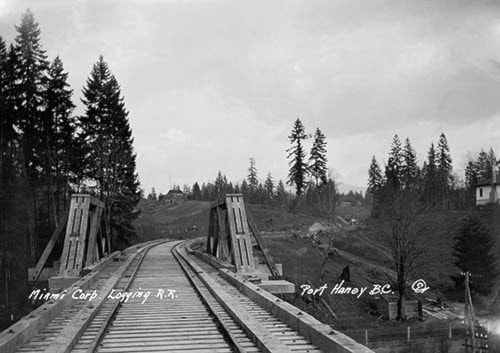Wayne Robinson had his interest tweaked during his regular walks along the Fraser River in Kanaka Creek park.
Here were the moldering remains of two log dumps and the train tracks that brought logs from the Abernethy & Lougheed Logging Company operations to form waterfront booms.
After Robinson looked up the information at the Maple Ridge Museum Archives, he spent many hours reading the New Westminster Columbian newspaper, available on microfiche at the Maple Ridge Llibrary. He copied many references to the A&L Logging Company that operated in the area north of Webster’s Corners and west of Alouette Lake from 1919 to 1931. He also consulted maps and photos from other archives.
In 1919, the Chicago-based Miami Corporation purchased timber rights covering 25,000 acres of forested land on the slopes of Golden Ears Mountains from the Dominion of Canada. Work began on the regular gauge railway that would carry loaded logging trains from the forest to the log dump at the mouth of Kanaka Creek. Four sturdy trestle bridges over the Alouette River and the CPR main line were constructed by Fraser River Pile Driving.
Local managers of the A&L operation were Nelson Lougheed and George Abernethy, established businessmen in the logging industry. One reason for creating the 30-acre booming grounds at the mouth of Kanaka Creek was to stockpile booms of valuable cedar and fir logs that could be easily towed downstream to numerous mills during the spring freshet. Five carloads of logs could be dumped at one time, to be formed into booms and secured to pilings.
In the Kanaka Creek area, there were a bunkhouse, cookhouse and machine shop, employing 40 men. Apparently there was also a six-hole golf course there, constructed on a flat area to keep the men busy (and not drinking) during waits between trains. Plans to build a large sawmill nearby were never carried out, a boon to the ecology of the area.
The main A&L headquarters camp was on a 40-acre site, now known as Allco Park. I had bunkhouses to accommodate the 700.
The machine shop manufactured much of the logging equipment. It was like a small town, with its own post office.
Robinson located part of the logging railway right-of-way at the footpath called Cottonwood North Park. He took a metal detector there, and uncovered a number of railway spikes and metal bolts that held a wooden fiche plate in place.
Many of the trails and roads in Golden Ears park follow the original rail lines, including the incline trail near Mike Lake, where empty railroad cars and locomotives were hoisted uphill.
Today’s photo shows the trestle bridge over River Road and the CPR tracks north of Kanaka Creek. Before loaded logging trains crossed over this trestle, they checked the CPR schedule to make sure no passenger trains were due.
A fire in 1929 curtailed the A&L operations, which shut down completely in 1931. The company was in financial difficulties, and had already logged off much of the timber.
We are gradually filling in the story of one of our pioneer industries, thanks to researchers like Wayne Robinson.
– by Sheila Nickols, past president of the Maple Ridge Historical Society.
